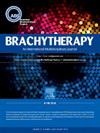Choosing between the best, the easiest and the most usual: Three different dose prescription methods for HDR vaginal-cuff brachytherapy planning in postoperative endometrial cancer
IF 1.7
4区 医学
Q4 ONCOLOGY
引用次数: 0
Abstract
PURPOSE
To evaluate and compare dosimetry parameters of three planning methods in high-dose-rate vaginal cuff brachytherapy (VCB) using cylinders for postoperative endometrial cancer (PEC).
MATERIAL AND METHODS
Two hundred seventeen patients were treated with 3D-based VCB for PEC, with the dose prescribed at 5 mm from the applicator surface. Three planning methods were retrospectively compared: T1-arm: point-based optimization at 5 mm from the applicator surface; T2-arm: volume-based optimization; T3-arm: graphical optimization. We evaluated the coverage index (CI), conformity index (COIN), D90 to clinical target volume (CTV) and dose to the organs at risk (OAR).
STATISTICS
Descriptive analysis, Chi-square test, Student`s t-test, GEE model, linear regression model.
RESULTS
The mean CI was greater than 0.9 in all treatment arms. The T2-arm provided the highest COIN value while T1-arm provided the highest CI value. The T3-arm delivered the lowest doses to the vaginal CTV, rectum and bladder. The linear regression model suggested that in the T3-arm, COIN showed improvement at the expense of CI and achieving a balance between CI and COIN may be more feasible when administering the T2-arm.
CONCLUSION
The T2-arm may be considered a general optimization method since it provides a better COIN within an acceptable D90 to the CTV. However, the T3-arm is easier in daily practice and could be more beneficial for patients who are more likely to develop late complications in OAR. More studies are needed to clarify the correlation of late complications with planning methods and dosimetry variables.
子宫内膜癌术后HDR阴道袖带近距离放射治疗方案的三种不同剂量处方选择。
目的:评价和比较三种高剂量率阴道袖带近距离气瓶治疗子宫内膜癌(PEC)的剂量学参数。材料和方法:217例患者使用基于3d的VCB治疗PEC,剂量在离涂抹器表面5mm处。回顾性比较了三种规划方法:t1 -臂:距涂抹器表面5mm处的点优化;t2臂:基于体积的优化;t3臂:图形优化。我们评估了覆盖指数(CI)、符合性指数(COIN)、D90对临床靶体积(CTV)和危及器官剂量(OAR)。统计学:描述性分析、卡方检验、学生t检验、GEE模型、线性回归模型。结果:所有治疗组的平均CI均大于0.9。t2组的COIN值最高,t1组的CI值最高。t3组给阴道CTV、直肠和膀胱的剂量最低。线性回归模型提示,在t3组中,以CI为代价,COIN表现出改善,在t2组中实现CI和COIN之间的平衡可能更可行。结论:t2臂可以被认为是一种通用的优化方法,因为它在可接受的D90范围内为CTV提供了更好的COIN。然而,t3臂在日常实践中更容易,对于更有可能出现桨叶晚期并发症的患者可能更有益。需要更多的研究来阐明晚期并发症与计划方法和剂量学变量的相关性。
本文章由计算机程序翻译,如有差异,请以英文原文为准。
求助全文
约1分钟内获得全文
求助全文
来源期刊

Brachytherapy
医学-核医学
CiteScore
3.40
自引率
21.10%
发文量
119
审稿时长
9.1 weeks
期刊介绍:
Brachytherapy is an international and multidisciplinary journal that publishes original peer-reviewed articles and selected reviews on the techniques and clinical applications of interstitial and intracavitary radiation in the management of cancers. Laboratory and experimental research relevant to clinical practice is also included. Related disciplines include medical physics, medical oncology, and radiation oncology and radiology. Brachytherapy publishes technical advances, original articles, reviews, and point/counterpoint on controversial issues. Original articles that address any aspect of brachytherapy are invited. Letters to the Editor-in-Chief are encouraged.
 求助内容:
求助内容: 应助结果提醒方式:
应助结果提醒方式:


